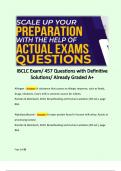IBCLC Exam/ 457 Questions with Definitive
Solutions/ Already Graded A+
Allergen - Answer: A substance that causes an allergic response, such as foods,
drugs, inhalants. Cow's milk is common source for infants.
Riordan & Wambach, 2010. Breastfeeding and Human Lactation (4th ed.), page
863.
Αlphalactalbumin - Answer: A major protein found in human milk whey. Assists in
processing lactose.
Riordan & Wambach, 2010. Breastfeeding and Human Lactation (4th ed.), page
863.
Page 1 of 95
,Alveolar ridge - Answer: The ridges on the upper and lower jaw where infant's
teeth will grow.
Riordan & Wambach, 2010. Breastfeeding and Human Lactation (4th ed.), page
863.
Alveolus, alveoli - Answer: Secrete and store milk for let down. Surrounded by
myoepithelial cells, contractile cells and connective tissue.
Riordan & Wambach, 2010. Breastfeeding and Human Lactation (4th ed.), page
80.
Amenorrhea - Answer: A natural phase of infertility that takes place when a
mother is exclusively breastfeeding. Menstruation has not returned.
Riordan & Wambach, 2010. Breastfeeding and Human Lactation (4th ed.), page
707 &865.
Amoxicillin - Answer: Antibiotic, L2. Observe for change in intestinal flora,
compatible.
Riordan & Wambach, 2010. Breastfeeding and Human Lactation (4th ed.), page
177.
Ampicillin - Answer: Antibiotic, L1. Observe for change in intestinal flora,
compatible.
Riordan & Wambach, 2010. Breastfeeding and Human Lactation (4th ed.), page
177.
Page 2 of 95
,Anaphylaxis - Answer: Hypersensitivity (as to foreign proteins or drugs) resulting
from sensitization following prior contact with the causative agent.
Merriam-Webster Medical Dictionary.
www.merriam-webster.com/medical/anaphylaxis.
Anchor scar - Answer: Surgical technique for breast reduction, slang.
Ankyglossia - Answer: A tongue tie. Characterized by a thick, short, or tight
frenulum under the tongue. Can cause breastfeeding issues, such as a painful
latch or inefficient milk transfer.
Anterior pituitary - Answer: This gland releases prolactin into the blood effecting
milk production and ejection. It is susceptible to stress.
Riordan & Wambach, 2010. Breastfeeding and Human Lactation (4th ed.), page
91.
Anthrax - Answer: Infectious disease caused by a spore-forming bacterium
(Bacillus anthrax), characterized by external ulcerating nodules or by lesions in the
lungs.
Merriam Webster Medical Dictionary.
www.merriam-webster.com/medical/anthrax.
Antibody - Answer: Immunoglobulin formed in response to an antigen, including
bacteria and viruses. Antibodies attack those bacteria or viruses helping the body
resist infection.
Page 3 of 95
, Riordan & Wambach, 2010. Breastfeeding and Human Lactation (4th ed.), page
863.
Antigen - Answer: Substance that stimulates antibody production. May be dust,
food, or bacteria.
Riordan & Wambach, 2010. Breastfeeding and Human Lactation (4th ed.), page
863.
Apgar score - Answer: Index to evaluate the condition of a newborn infant based
on a rating of 0, 1, or 2 for color, heart rate, reflex response, muscle tone, and
respiration with 10 being a perfect score.
Merriam-Webster Medical Dictionary. www.merriam-webster.com/medical/apgar
%20score.
Apocrine gland - Answer: Sweat glands located on the areola that secrete a scent.
Mannel, Martens & Walker, 2008. Core Curriculum for Lactation Consultant
Practice (2nd ed.), page 197-198.
Apoptosis - Answer: Programmed normal cell death.
Riordan & Wambach, 2010. Breastfeeding and Human Lactation (4th ed.), page
863.
Applied research - Answer: Research that focuses on solving or finding an answer
to a clinical or practical problem.
Page 4 of 95




